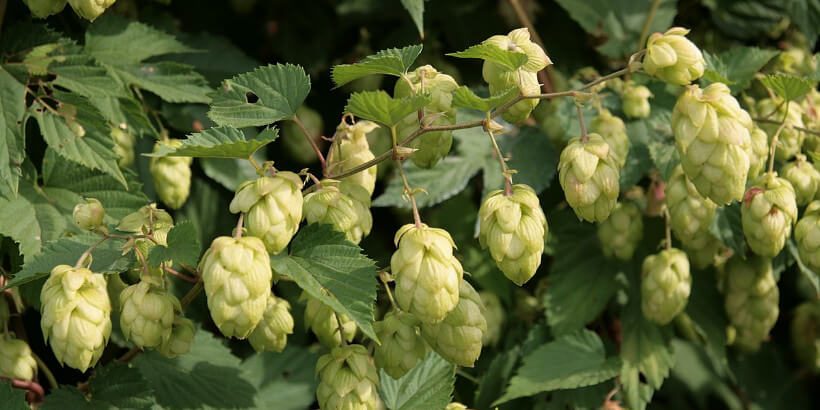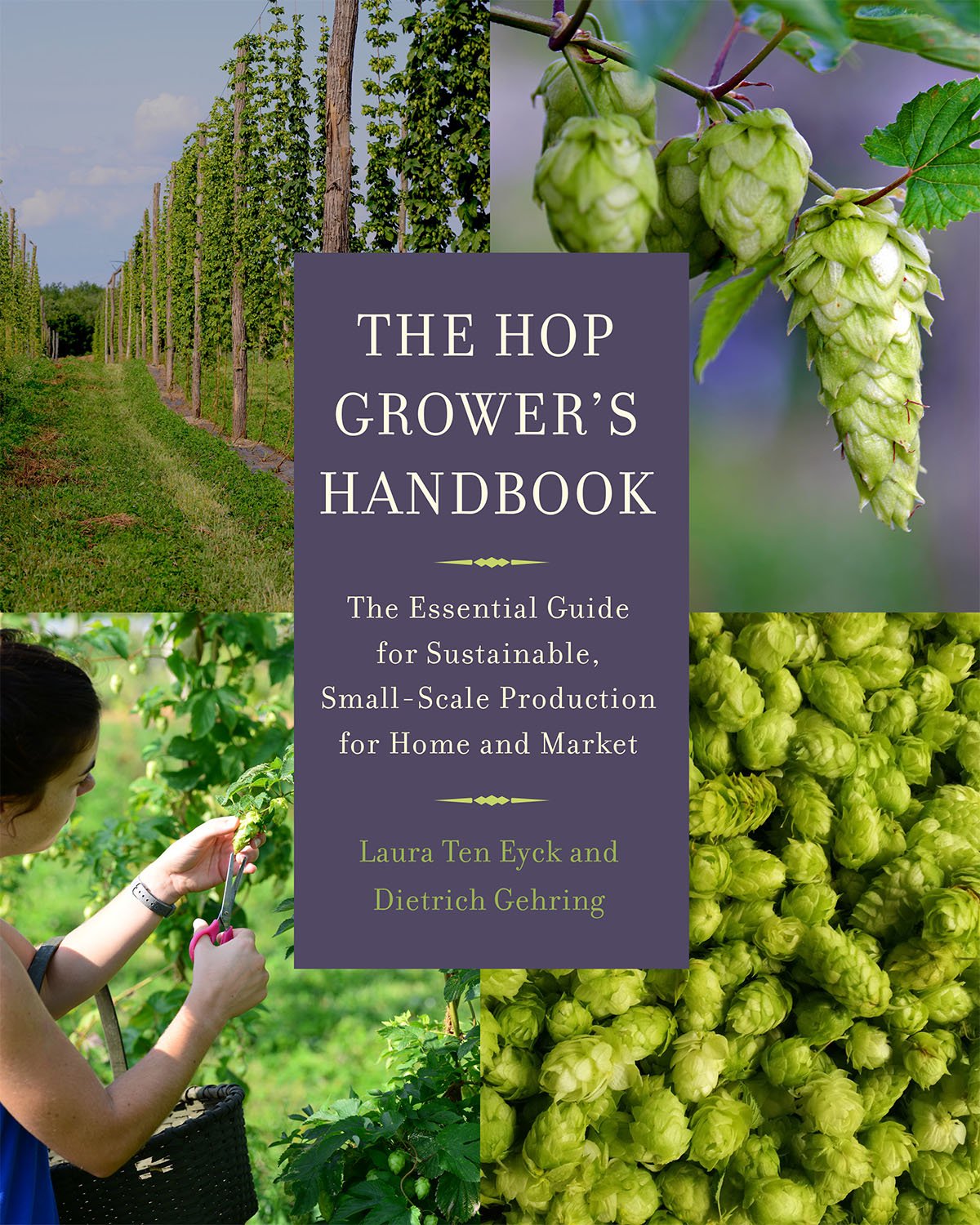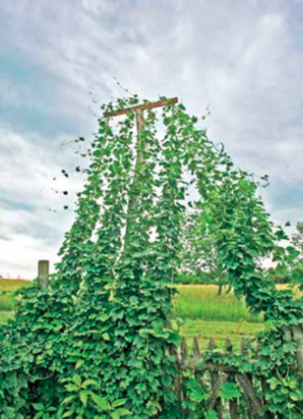Why You Need to Drink Wet-Hopped Beer Right Now

Wet-hopped beer is the ultimate in seasonal and local brews. It is made from fresh hops picked right off the bine in order to capture the aromatic hop flavor when it is most potent. The tricky part is fresh hops have virtually no shelf life, so brewers must spring into action as soon as the hops have reached maturity and begin the wet-hop brewing process within hours of harvest. Since the hop harvest usually happens between August and September and the beer needs to sit for a few weeks before it is ready to drink, October is the best time to enjoy a fresh wet-hop brew.
Learn more about the wet-hop brewing process and how to easily infuse your own beer with fresh hops in the following excerpt from The Hop Grower’s Handbook by Laura Ten Eyck and Dietrich Gehring.
These two hop farmers and owners of Indian Ladder Farmstead Brewery & Cidery are helping to spur a local hops renaissance in the Eastern United States, a region where hops have not been grown commercially for nearly a century. Their new book shows that it is possible to grow hops on a small-scale for the booming regional craft beer markets and not only do it profitably, but also sustainably. The Hop Grower’s Handbook includes information on hop yard design and site selection, best practices to manage moisture, weeds, pests, and disease, harvesting and processing techniques, beer recipes, and more.
Publishers Weekly calls it, “an indispensable resource for the prospective microbrewer and a great study of the wonders of this little-known plant.”
Check out the “wonders” of brewing with wet hops in the excerpt below and browse these related links for more craft beer news.
Brewing with Wet Hops
Because wet hops have virtually no shelf life, brewers use them fresh off the bine within hours of harvest in seasonal brews that showcase the ephemeral fresh-hop flavor and aroma that appreciative beer drinkers have struggled to describe in numerous ways, including earthy, floral, grassy, vegetative, chlorophyllic, spicy, herbal, and evergreen.
Difference Between Fresh Hop and Dry Hop Flavor
Why do fresh hops produce such different aromas and flavors from dry hops in beer? These differences are created by the levels and types of volatile hop oils contained within the hop cones. As the word “volatile” indicates, these oils have a tendency to easily and quickly transform into vapor—and evaporation begins the minute the hop cones hit the air after harvest. In fact the great rush to dry, process, and package hops after they are harvested is driven by the desire to minimize the loss of the cone’s hop oils and acids. Brewing with wet hops bypasses all this and simply introduces the fresh, intensely aromatic hop flowers, sticky with volatile oils, directly into the brew kettle, where the hop’s very essence is captured.
Because of the nature of the relatively short hop harvest and extremely short shelf life of fresh hops, wet-hop beer is a truly seasonal product that can only be made during the hop harvest season. In addition, because the freshly picked hops must be used within twenty-four hours of harvest, at its best a wet-hop beer is a truly local product as well. Wet-hop brewing is an opportunity for the local farmer and the local brewer to work in concert to create something both ephemeral and amazing—but it requires planning.
The Wet-Hop Brewing Process – Timing is Everything
First, a brewer must be interested in working with wet hops. It is harder to brew beer with wet hops, and recipes have to be adjusted. Wet hops are not as bitter by weight as dry hops so a brewer has to add four to six times more wet hops than dry to get the same result. For example, converting to wet hops for a home brew recipe that calls for 1/2 ounce (14.2 grams) of dry hops will mean the brewer has to add 2 or 3 ounces (56.7 to 85.1 grams) of wet hops. For a commercial brewer measuring hops in pounds, the additional space needed can be a logistical problem, not only in the brew kettle but in the brewery itself.
But there are bigger issues. In wet-hop brewing timing is everything. The grower needs to let the brewer know as the hops begin to reach maturity, and the brewer has to plan accordingly. Selling wet hops to a brewer is often a great way for a new hop grower, who does not have access to drying and processing equipment, to sell his first crop. If the grower doesn’t yet have a harvesting machine, sometimes an enthusiastic brewery will even send their staff to come and handpick the hops. This can be a great opportunity for the brewer and staff to get out of the brewery and reconnect with the agricultural nature of their product. One way or another, once the hop cones are removed from the bines, they have to begin their journey to the brew kettle, and fast. This is a case in which the best product is simply the freshest product. But even the best laid plans can fall apart. If the hops can’t be used within the recommended twenty-four hours, some have had luck refrigerating the hops for a few days before they are used. Whatever you do, don’t let the hops sit around in bags or boxes at room temperature. Fresh-picked hops, like fresh-cut hay, heat up when they sit. In the case of hops the rising temperature degrades the quality of the hops, accelerating the evaporation of those volatile oils.
If you know it is hop harvest season (late August to mid-September) and you are ready to drink wet-hopped ale, remember that once the fresh-hops beer is brewed it has to sit for two to four weeks before it is ready to drink. So it may not actually be available until later in September or early October. The fresh nature of the product applies to the beer as well, which should be drunk within three months of its brew date. All this adds up to the beer version of Beaujolais nouveau, with its own kind of hype.
Bringing the Wet-Hop Beer Craze to the East Coast
Wet-hop brews form the foundation of hop festivals in the hop-growing regions of the northwestern United States. Judging from media coverage and advertising, beer drinkers and brewers alike out there are positively crazed about wet-hop ale and will go to great extremes to make and drink it. Without local hops until recently, the eastern part of the country has been left out of this tradition—but the hop renaissance here means that local breweries are connecting with fledgling hop growers to seek out wet hops. The Hop Yard, in Maine, sold its entire 2014 harvest as wet hops to a handful of Maine breweries. C. H. Evans Brewing Company has brewed beer with wet hops from our farm for two years in a row, serving the beer Wet Hop Harvest at the Albany Pump Station in Albany, New York. But brewing with wet hops can be both messy and unpredictable, and some small brewers with limited human resources and production capabilities who are hard-pressed to keep up with demand for their product under the best of circumstances have been understandably reluctant to take the plunge.
Infuse Your Own Beer With Fresh Hops
Ever-curious home brewers are always anxious to get their hands on wet hops for their beers, and even beer drinkers who are not brewers can experiment by wet-hopping beer that’s already been brewed. There is a device brewers use called a Randall that comes in handy for this. It is a plastic cylinder that you can stuff full of hops, wet or dry. One end attaches to the tap and the other to a spigot. The beer is pumped through the hops, absorbing the flavors and aromas, and into the beer glass, ready for consumption.
Another trick for hop lovers is to put hops into a French coffee press and fill it with beer. Let it sit for a while, then press the hops down to the bottom of the container and pour the beer into a glass for a wet-hop-infused drink. An even simpler method of integrating fresh hops, and one that is enjoyed frequently on our farm during harvest, is to fill a glass with beer and drop a few fresh hop flowers into it. Each sip will overwhelm you with hoppiness.
Recent Articles
Garden strawberries are excellent for both covering the ground and for growing fruit. If you’re planning out a forest garden, or are just looking for a plant to use as ground cover, strawberries are a great option. The following is an excerpt from The Home-Scale Forest Garden by Dani Baker. It has been adapted for…
Read MoreAsparagus is a delicious vegetable with a layered history. How did this aspiring spear make its way from growing in the wild to appearing on our plates? The following is an excerpt from the The Seed Detective by Adam Alexander. It has been adapted for the web. “Nature gives us the key to every secret…
Read MoreInterested in growing trees? Here are some tips on successfully planting, transplanting, and pruning trees to create a flourishing forest garden! The following is an excerpt from The Home-Scale Forest Garden by Dani Baker. It has been adapted for the web. Planting Potted Trees and Shrubs If you order potted trees, check with your supplier to…
Read MoreChances are, you’ve seen cattails growing on the edge of your local lake or stream at least once or twice. Instead of just passing these plants, try foraging for and cooking them to create delicious seasonal dishes! The following excerpt is from The New Wildcrafted Cuisine by Pascal Baudar. It has been adapted for the…
Read MoreWith the right strategies and practices, composting on a small farm is surprisingly easy and inexpensive. Just follow these steps for making compost, and your farm will be thriving in no time! The following excerpt is from The Lean Farm Guide to Growing Vegetables by Ben Hartman. It has been adapted for the web. (All photographs by Ben…
Read More









